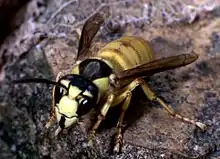Vespa bicolor
Vespa bicolor, the black shield wasp, described by Johan Christian Fabricius in 1787, is a species of hornet which has been found to be the pollinator of an orchid,[1] Dendrobium sinense (syn. Dendrobium christyanum), found only on the Chinese island of Hainan. Vespa bicolor also preys on honey bees, which it feeds to its larvae. The orchid produces a chemical that mimics a honey bee pheromone and attracts this predatory wasp.
| Black shield wasp | |
|---|---|
 | |
| Scientific classification | |
| Kingdom: | Animalia |
| Phylum: | Arthropoda |
| Class: | Insecta |
| Order: | Hymenoptera |
| Family: | Vespidae |
| Genus: | Vespa |
| Species: | V. bicolor |
| Binomial name | |
| Vespa bicolor Fabricius, 1787 | |
Vespa bicolor is the most common species of large wasp in Hong Kong, along with members of the genus Parapolybia. It is found in a wide range of environments and can be found near human dwellings.
References
- Brodmann, Jennifer; Twele, Robert; Francke, Wittko; Yi-bo, Luo; Xi-qiang, Song; Ayasse, Manfred (August 25, 2009). "Orchid Mimics Honey Bee Alarm Pheromone in Order to Attract Hornets for Pollination" (PDF). Current Biology. 19 (6): 1368–1372. doi:10.1016/j.cub.2009.06.067.
This article is issued from Wikipedia. The text is licensed under Creative Commons - Attribution - Sharealike. Additional terms may apply for the media files.